Jia-Yu Pan
Contextual Temperature for Language Modeling
Dec 25, 2020



Abstract:Temperature scaling has been widely used as an effective approach to control the smoothness of a distribution, which helps the model performance in various tasks. Current practices to apply temperature scaling assume either a fixed, or a manually-crafted dynamically changing schedule. However, our studies indicate that the individual optimal trajectory for each class can change with the context. To this end, we propose contextual temperature, a generalized approach that learns an optimal temperature trajectory for each vocabulary over the context. Experimental results confirm that the proposed method significantly improves state-of-the-art language models, achieving a perplexity of 55.31 and 62.89 on the test set of Penn Treebank and WikiText-2, respectively. In-depth analyses show that the behaviour of the learned temperature schedules varies dramatically by vocabulary, and that the optimal schedules help in controlling the uncertainties. These evidences further justify the need for the proposed method and its advantages over fixed temperature schedules.
Remix: Rebalanced Mixup
Jul 08, 2020



Abstract:Deep image classifiers often perform poorly when training data are heavily class-imbalanced. In this work, we propose a new regularization technique, Remix, that relaxes Mixup's formulation and enables the mixing factors of features and labels to be disentangled. Specifically, when mixing two samples, while features are mixed up proportionally in the same fashion as Mixup methods, Remix assigns the label in favor of the minority class by providing a disproportionately higher weight to the minority class. By doing so, the classifier learns to push the decision boundaries towards the majority classes and balances the generalization error between majority and minority classes. We have studied the state of the art regularization techniques such as Mixup, Manifold Mixup and CutMix under class-imbalanced regime, and shown that the proposed Remix significantly outperforms these state-of-the-arts and several re-weighting and re-sampling techniques, on the imbalanced datasets constructed by CIFAR-10, CIFAR-100, and CINIC-10. We have also evaluated Remix on a real-world large-scale imbalanced dataset, iNaturalist 2018. The experimental results confirmed that Remix provides consistent and significant improvements over the previous state-of-the-arts.
Calibrated BatchNorm: Improving Robustness Against Noisy Weights in Neural Networks
Jul 07, 2020



Abstract:Analog computing hardware has gradually received more attention by the researchers for accelerating the neural network computations in recent years. However, the analog accelerators often suffer from the undesirable intrinsic noise caused by the physical components, making the neural networks challenging to achieve ordinary performance as on the digital ones. We suppose the performance drop of the noisy neural networks is due to the distribution shifts in the network activations. In this paper, we propose to recalculate the statistics of the batch normalization layers to calibrate the biased distributions during the inference phase. Without the need of knowing the attributes of the noise beforehand, our approach is able to align the distributions of the activations under variational noise inherent in the analog environments. In order to validate our assumptions, we conduct quantitative experiments and apply our methods on several computer vision tasks, including classification, object detection, and semantic segmentation. The results demonstrate the effectiveness of achieving noise-agnostic robust networks and progress the developments of the analog computing devices in the field of neural networks.
Learning with Hierarchical Complement Objective
Nov 17, 2019



Abstract:Label hierarchies widely exist in many vision-related problems, ranging from explicit label hierarchies existed in image classification to latent label hierarchies existed in semantic segmentation. Nevertheless, state-of-the-art methods often deploy cross-entropy loss that implicitly assumes class labels to be exclusive and thus independence from each other. Motivated by the fact that classes from the same parental category usually share certain similarity, we design a new training diagram called Hierarchical Complement Objective Training (HCOT) that leverages the information from label hierarchy. HCOT maximizes the probability of the ground truth class, and at the same time, neutralizes the probabilities of rest of the classes in a hierarchical fashion, making the model take advantage of the label hierarchy explicitly. The proposed HCOT is evaluated on both image classification and semantic segmentation tasks. Experimental results confirm that HCOT outperforms state-of-the-art models in CIFAR-100, ImageNet-2012, and PASCAL-Context. The study further demonstrates that HCOT can be applied on tasks with latent label hierarchies, which is a common characteristic in many machine learning tasks.
Improving Adversarial Robustness via Guided Complement Entropy
Mar 23, 2019



Abstract:Model robustness has been an important issue, since adding small adversarial perturbations to images is sufficient to drive the model accuracy down to nearly zero. In this paper, we propose a new training objective "Guided Complement Entropy" (GCE) that has dual desirable effects: (a) neutralizing the predicted probabilities of incorrect classes, and (b) maximizing the predicted probability of the ground-truth class, particularly when (a) is achieved. Training with GCE encourages models to learn latent representations where samples of different classes form distinct clusters, which we argue, improves the model robustness against adversarial perturbations. Furthermore, compared with the state-of-the-arts trained with cross-entropy, same models trained with GCE achieve significant improvements on the robustness against white-box adversarial attacks, both with and without adversarial training. When no attack is present, training with GCE also outperforms cross-entropy in terms of model accuracy.
Complement Objective Training
Mar 21, 2019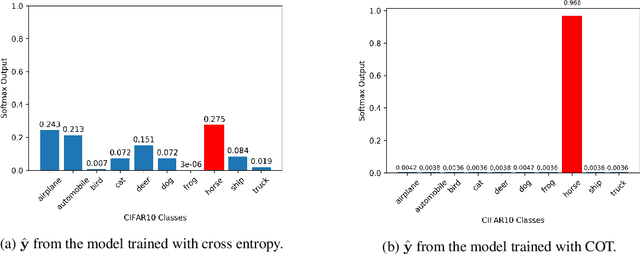

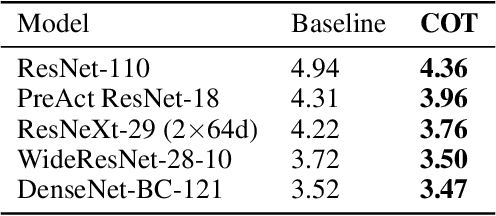

Abstract:Learning with a primary objective, such as softmax cross entropy for classification and sequence generation, has been the norm for training deep neural networks for years. Although being a widely-adopted approach, using cross entropy as the primary objective exploits mostly the information from the ground-truth class for maximizing data likelihood, and largely ignores information from the complement (incorrect) classes. We argue that, in addition to the primary objective, training also using a complement objective that leverages information from the complement classes can be effective in improving model performance. This motivates us to study a new training paradigm that maximizes the likelihood of the groundtruth class while neutralizing the probabilities of the complement classes. We conduct extensive experiments on multiple tasks ranging from computer vision to natural language understanding. The experimental results confirm that, compared to the conventional training with just one primary objective, training also with the complement objective further improves the performance of the state-of-the-art models across all tasks. In addition to the accuracy improvement, we also show that models trained with both primary and complement objectives are more robust to single-step adversarial attacks.
Searching Toward Pareto-Optimal Device-Aware Neural Architectures
Aug 30, 2018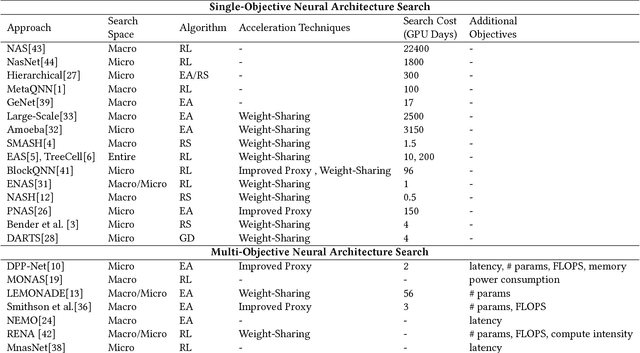
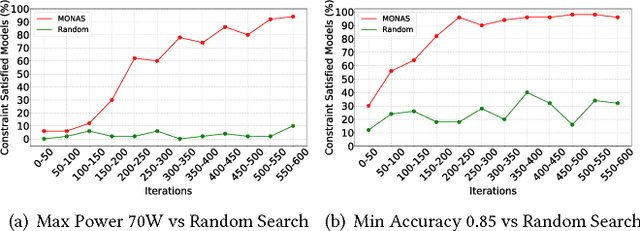
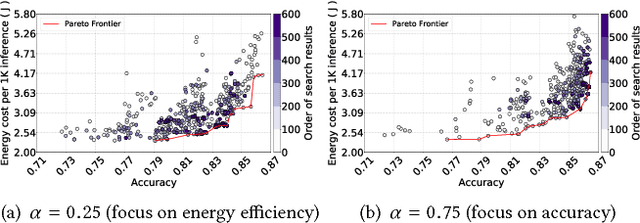

Abstract:Recent breakthroughs in Neural Architectural Search (NAS) have achieved state-of-the-art performance in many tasks such as image classification and language understanding. However, most existing works only optimize for model accuracy and largely ignore other important factors imposed by the underlying hardware and devices, such as latency and energy, when making inference. In this paper, we first introduce the problem of NAS and provide a survey on recent works. Then we deep dive into two recent advancements on extending NAS into multiple-objective frameworks: MONAS and DPP-Net. Both MONAS and DPP-Net are capable of optimizing accuracy and other objectives imposed by devices, searching for neural architectures that can be best deployed on a wide spectrum of devices: from embedded systems and mobile devices to workstations. Experimental results are poised to show that architectures found by MONAS and DPP-Net achieves Pareto optimality w.r.t the given objectives for various devices.
MONAS: Multi-Objective Neural Architecture Search using Reinforcement Learning
Jun 27, 2018



Abstract:Recent studies on neural architecture search have shown that automatically designed neural networks perform as good as human-designed architectures. While most existing works on neural architecture search aim at finding architectures that optimize for prediction accuracy. These methods may generate complex architectures consuming excessively high energy consumption, which is not suitable for computing environment with limited power budgets. We propose MONAS, a Multi-Objective Neural Architecture Search with novel reward functions that consider both prediction accuracy and power consumption when exploring neural architectures. MONAS effectively explores the design space and searches for architectures satisfying the given requirements. The experimental results demonstrate that the architectures found by MONAS achieve accuracy comparable to or better than the state-of-the-art models, while having better energy efficiency.
 Add to Chrome
Add to Chrome Add to Firefox
Add to Firefox Add to Edge
Add to Edge